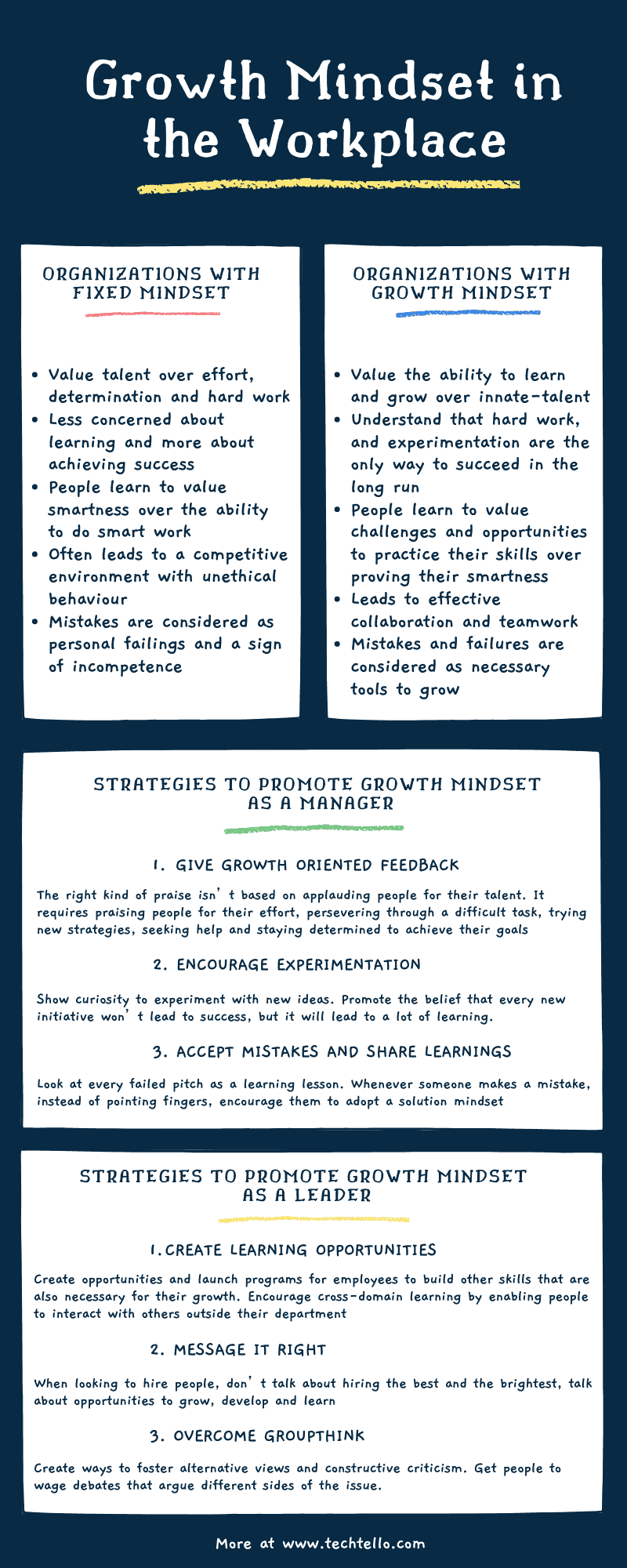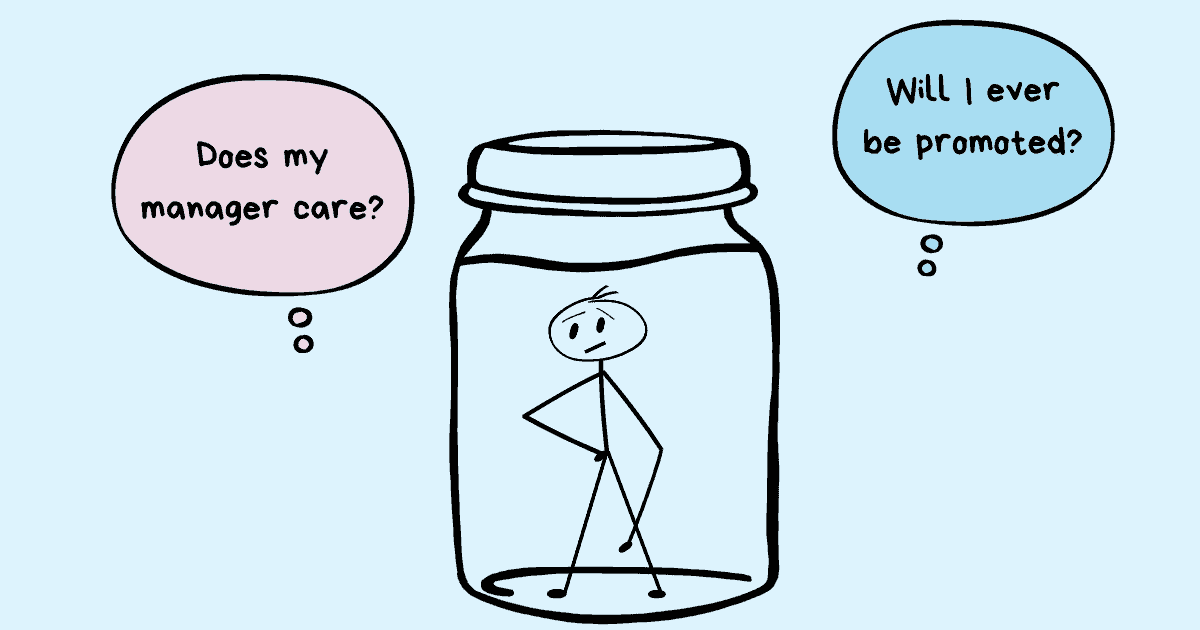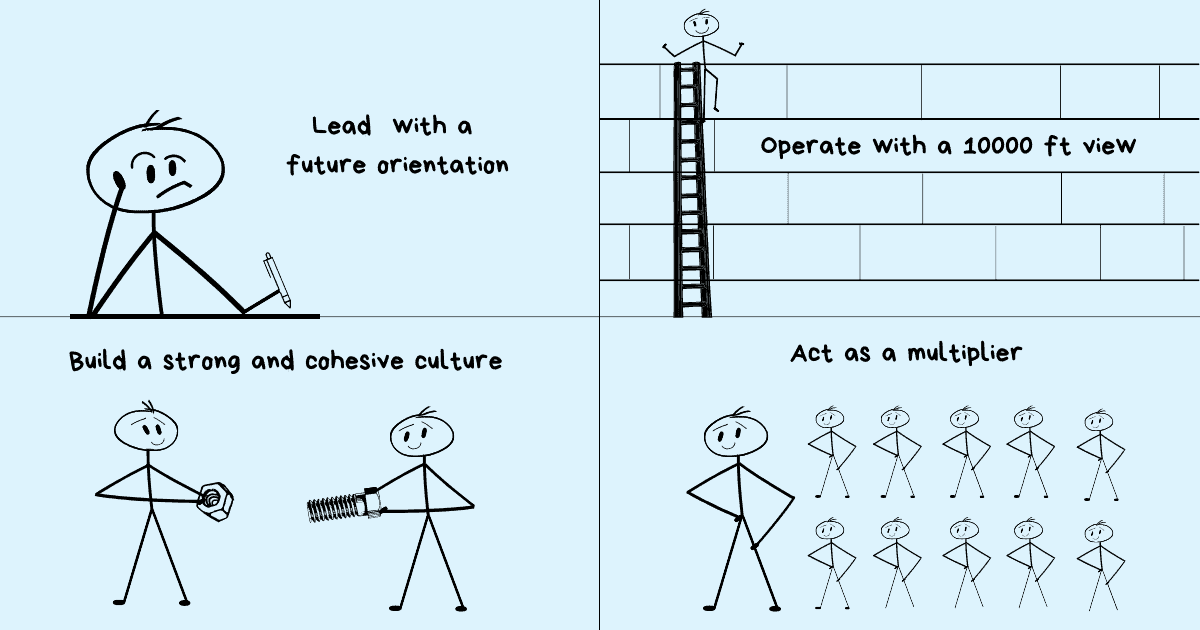How To Promote a Growth Mindset in the Workplace

I have worked with two different kinds of leaders and managers over the years. The one who believes in fixed abilities and promotes a fixed mindset “those who don’t perform well can never do better” and the other who believes in growing those abilities thereby promoting a growth mindset “people can be coached into improving their skills.”
The first kind engages with the workplace to boost their self-esteem, establish their superiority and prove their smartness. They focus on their employees’ weaknesses, refuse to coach them, blame others for failure, do not seek feedback, divide people into competent or incompetent and hire for natural talent instead of looking for ways to grow talent within their organization. They praise people for their intelligence while failing to take notice of those who show improvement through effort and hard work. After all, their fixed mindset leads them with the belief that people can’t get any better and that makes them stick with their initial impression about them.
How can you spot them? You will often see them shutting down people and their ideas. They refuse to take responsibility for failures, discourage dissent, treat mistakes as a personal fault and give feedback that puts talent above effort.
The second kind engages with the workplace to create a learning environment providing development opportunities with focus on a high learning culture. They focus on their employees’ strengths, coach them into developing critical thinking skills, take responsibility for failures, engage with the conflict with the desire to gain knowledge, seek critical feedback to learn from criticism and hire people who show the desire to learn and grow. They invest in people and their growth since they believe that anyone can get better with the right kind of strategies, determination and persistence.
How can you spot them? You will often see their eyes light up with curiosity while listening to new ideas. They embrace challenges, offer advice to experiment, try harder and implement better strategies. They encourage difference of opinion, using failures and mistakes as valuable lessons to get better and give feedback that involves personal mastery. In other words, they help you become the best version of yourself.
What’s the impact of this mindset on employees?
Employees who work for growth mindset organizations where learning and growth is highly valued have far more trust in their company and a greater sense of empowerment and ownership. They are more committed to their companies and ready to go the extra mile for it. They welcome challenges, work harder, and persevere in the face of struggle which makes them more successful learners and better contributors to their organizations.
Stanford University psychologist Carol Dweck’s research has found that employees in a “growth mindset” company are:
- 47% likelier to say that their colleagues are trustworthy,
- 34% likelier to feel a strong sense of ownership and commitment to the company,
- 65% likelier to say that the company supports risk taking, and
- 49% likelier to say that the company fosters innovation.
She writes in Mindset “Employees in the fixed-mindset companies not only say that their companies are less likely to support them in risk-taking and innovation, they are also far more likely to agree that their organizations are rife with cutthroat or unethical behavior. When organizations put the premium on natural talent, then everyone wants to be the superstar, everyone wants to shine brighter than the others, and people may be more likely to cheat or cut corners to do so. Teamwork can take a nosedive.”
She suggests “Our best bet is not simply to hire the most talented managers we can find and turn them loose, but to look for managers who also embody a growth mindset: a zest for teaching and learning, an openness to giving and receiving feedback, and an ability to confront and surmount obstacles. It also means we need to train leaders, managers, and employees to believe in growth, in addition to training them in the specifics of effective communication and mentoring.”
Main attributes of a growth mindset workplace
A growth mindset environment in which people can thrive:
- Value hard work, determination and perseverance over talent
- Help employees learn new skills
- Coach them to develop critical thinking skills to navigate challenging problems
- Encourage experimentation to try new ideas
- Use failures as valuable learning opportunities
- Empower to take responsibility and own up to mistakes
- Encourage people to speak up and respect diverse viewpoints
- Give feedback that promotes learning and desire to get better
Growth mindset environment promotes the idea that anyone can succeed if they apply the right strategies, work hard and ask for help to improve a little each day. People may have plenty of talent and still achieve nothing. It’s the effort that builds skills and it’s the effort that turns those skills into accomplishment.
Angela Duckworth writes in Grit “Talent is not all there is to achievement. Talent is how quickly your skills improve when you invest effort. Achievement is what happens when you take your acquired skills and use them. Skill is not the same thing as achievement. Without effort, your talent is nothing more than your unmet potential. Without effort, your skill is nothing more than what you could have done but didn’t. With effort, talent becomes skill and, at the very same time, effort makes skill productive.”
Questions to examine mindset in the workplace
Examine how your own mindset is getting in the way of your growth and those of people around you. If you are a manager or a leader, your mindset can have a profound impact on others.
Are you in a fixed-mindset or growth-mindset workplace?
- How do people around you behave?
- Do you feel being judged all the time or others help you grow?
- How are mistakes and failures handled in the workplace?
- Does your company promote talent or effort?
- Are you encouraged to build new skills?
- How has been your learning in the past?
- Does your manager encourage you to do better?
- Does your manager coach you into solving problems on your own?
- Do you feel a greater sense of empowerment and ownership?
- Does your company encourage risk-taking and innovation?
- Do you find your colleagues trustworthy?
Have you considered the possibility that you can be a problem?
- How do you react to mistakes? Are you defensive about them or use them as a learning opportunity to get better?
- Do you apply the feedback that you get or simply ignore it?
- Do you seek criticism as a tool to get better?
- What’s your behaviour towards others in the workplace? Do you try to take advantage of others? Do you demean them?
- Do you worry about high performing employees in your organization? Do they threaten you or challenge you to do better?
- Do you embrace new opportunities as a learning experience or avoid them with fear of failure?
- Do you spend time in building new skills or spend the same time blaming others for everything not going so well for you?
Strategies to promote growth mindset as a manager
If you are a manager, consider ways in which you can promote a growth mindset on the job. What are the ways in which you can help employees build new skills – coaching? How can you hire people who value learning over talent? What can you do to encourage collaboration and effective team communication? How can you promote teamwork, knowledge sharing, open communication and learning over the desire to look smart? What strategies can you employ to maximize your team’s potential and grow their knowledge?
Apply these 3 strategies to promote growth mindset in the workplace as a manager:
1. Give growth oriented feedback
While giving constructive criticism, ensure your employees feel in control of their situation. Even when they feel vulnerable, they shouldn’t engage in self-doubt. Because feeling that they can’t really do much to fix the situation can lead to pessimism and fixed mindset thinking about their abilities – considering the situation as permanent and pervasive as opposed to attaching a more specific and temporary explanation. They can spiral into hopelessness with the fear that nothing they do can fix their situation – helpless, hopeless, not good enough, not worthy enough.
If you want them to take responsibility for their own failures, don’t undermine their sense of control over their own performance. Rather, encourage them to see how a change in their behaviour and actions can be useful to get over this temporary bump in the road. Without a sense of how they can make things better, they might either consider themselves as a failure or get defensive in order to protect their self-esteem, leading to a fixed mindset.
Telling people how smart they are when they achieve a big milestone or do otherwise great work also promotes a belief in the fixed mindset – talent and success is all that matters. It can make them feel good in the moment, but it interferes with their ability to handle setbacks later. They refuse to acknowledge mistakes. They consider failure as a reflection on their incompetence. They are reluctant to take up new challenges with the fear they might fail. They try to say and do things to showcase their smartness and prove their brilliance as opposed to embracing opportunities that will make them learn.
The right kind of praise isn’t based on applauding people for their talent. It’s given with the purpose to promote a growth mindset – skills and abilities can be built with the right kind of effort. It requires praising people for their effort, persevering through a difficult task, trying new strategies, seeking help and staying determined to achieve their goals.
2. Encourage experimentation
Show curiosity to experiment with new ideas. Promote the belief that every new initiative won’t lead to success, but it will lead to a lot of learning.
When someone voices their opinion, show enthusiasm to explore it further “tell me more about this idea.” Even if it does not seem right at first or does not match your opinion, do not reject without hearing out first. Rather, help them evaluate their own ideas using a framework to make better decisions:
- Why is this idea useful?
- What problem does it solve and why is it important?
- What are the risks associated with not solving it?
- Why do they think this is the right time?
- How much time/effort will it take? Where does it stack against other priorities on our list?
Managers can promote a growth mindset in the workplace by making people feel safe to raise their hands and share their viewpoint, to experiment, to explore, and most importantly to value their contribution without judging it based on specific outcomes. When they try something new – a new strategy, a challenging project, recognize it, regardless of whether it leads to success or not.
3. Accept mistakes and share learnings
Look at every failed pitch as a learning lesson. Whenever someone makes a mistake or fails at something, instead of pointing fingers, encourage them to adopt a solution mindset by asking these questions:
- What caused this to not work? Use the five-whys technique designed by Sakichi Toyoda who used it within Toyota Motor Corporation during the evolution of its manufacturing methodologies to get to the underlying root-cause. Encourage employees to shift from self-justification to self-awareness.
- What strategies can you employ to fix this situation?
- What has been your most valuable learning from this mistake or failure?
Another important strategy to promote a growth mindset in the workplace is to share your own mistakes and failures. When employees see their managers open up about their own vulnerabilities, they feel safe to accept their own shortcomings instead of hiding behind them.
As Brene Brown writes in Daring Greatly “Vulnerability is not weakness, and the uncertainty, risk, and emotional exposure we face every day are not optional. Our only choice is a question of engagement. Our willingness to own and engage with our vulnerability determines the depth of our courage and the clarity of our purpose; the level to which we protect ourselves from being vulnerable is a measure of our fear and disconnection.”
Managers can promote a growth mindset by choosing courage and clarity over fear and disconnection.
Strategies to promote growth mindset as a leader
While a manager’s impact is typically limited to their team, it’s the leader who sets the tone for the entire organization. They need to take initiatives to promote a growth mindset in the workplace. The idea that effort, hard work, learning and growth is valued more than talent shouldn’t be communicated only through speech, it should be demonstrated in their action.
Apply these 3 strategies to promote growth mindset in the workplace as a leader:
1. Create learning opportunities
Launch programs where people can learn new skills. A leader of a technology department shouldn’t focus only on their people’s technical skills, but create opportunities for employees to build other skills that are also necessary for their growth. Communication, collaboration, conflict management, decision making, risk-analysis, estimation, strategic planning and prioritization are equally important to have a successful career.
Encourage cross-domain learning by enabling people to interact with others outside their department. E.g. people in technology to interact with marketing and design. It not only builds better relationships at work, but also leads to better problem solving. Cross-domain thinking can be extremely powerful to recombine ideas from multiple disciplines and solve problems.
People who have adopted cross-domain thinking have revolutionized industries. Charles Babbage’s invention of computational machines powered by punch cards was inspired by his knowledge of the silk-weaving industry, which used cards with holes to create patterns in the silk fabric. Henry Ford’s idea of the car manufacturing assembly line was inspired by Singer sewing machines and meat-packing plants. Claude Shannon combined telephone call-routing technology with his knowledge of boolean algebra to encode and transmit information electronically.
David Epstein wrote about how generalists triumph in a specialized world in Range “Increasing specialization has created a system of parallel trenches in the quest for innovation. Everyone is digging deeper into their own trench and rarely standing up to look in the next trench over, even though the solution to their problem happens to reside there…Modern life requires range, making connections across far-flung domains and ideas…Our greatest strength is the exact opposite of narrow specialization. It is the ability to integrate broadly.”
2. Message it right
When looking to hire people, don’t talk about hiring the best and the brightest, talk about opportunities to grow, develop and learn. Don’t tolerate toxic behaviour even if it comes from your most valuable employee. Set the right example for everyone by helping the person correct their behaviour or letting them go if they refuse to change.
Don’t reward people for their exemplary performance, reward them for their hard work, their strategies, their ability to tackle challenges and for their perseverance. Use language that communicates a growth mindset message “we value learning and growth over talent and success.”
Celebrate failures with the desire to learn from them – actively kill ideas that don’t really matter, host idea funerals to create a safe space for people to learn from their failures, change KPIs to reward risks. These are just a few ways to promote the growth mindset in the organization.
3. Overcome groupthink
Fixed mindset leads to groupthink, a tendency to conform to ideas and beliefs with conservative thinking, ignoring potential signs of failure, and making decisions with incomplete and biased information. When such behavior becomes part of an organization’s culture, it gives rise to collective blindness to unethical ways, regressive thinking that ignores the future demands of business and a propensity to ignore truth especially if it requires taking a hard stance.
Carol Dweck writes in Mindset “There are so many ways the fixed mindset creates groupthink. Leaders are seen as gods who never err. A group invests itself with special talents and powers. Leaders, to bolster their ego, suppress dissent. Or workers, seeking validation from leaders, fall into line behind them. That’s why it’s critical to be in a growth mindset when important decisions are made. By relieving people of the illusions or the burdens of fixed ability—leads to a full and open discussion of the information and to enhanced decision making.”
What can leaders do to avoid groupthink and promote growth mindset? She writes “Create ways to foster alternative views and constructive criticism. Assign people to play the devil’s advocate, taking opposing viewpoints so you can see the holes in your position. Get people to wage debates that argue different sides of the issue. Have an anonymous suggestion box that employees must contribute to as part of the decision-making process. Remember, people can be independent thinkers and team players at the same time. Help them fill both roles.”
Summary
Organizations that promote fixed mindset:
- Value talent over effort, determination and hard work.
- They are less concerned about learning and more about achieving success.
- Managers and leaders in such organizations are less likely to support risk-taking and innovation. They are more focused on establishing their power in the organization than taking care of employees’ well-being.
- People learn to value smartness over the ability to do smart work.
- Often leads to a competitive environment with unethical behaviour where success at all costs is valued.
- Mistakes are considered as personal failings and a sign of incompetence.
Organizations that promote growth mindset:
- Value the ability to learn and grow over innate-talent.
- Understand that hard work, determination and experimentation are the only way to succeed in the long run.
- Managers and leaders in such organizations encourage risk-taking and innovation. They empower their people to develop critical thinking skills for better decision-making.
- People learn to value challenges and opportunities to practice their skills over proving their smartness. They aren’t afraid to voice their opinions and enjoy constructive disagreements.
- Leads to effective collaboration and teamwork.
- Mistakes and failures are considered as necessary tools to grow.































I enjoyed reading. I feel motivated. Keep me posted, I will feel much obliged and happy. Thanks. Have a nice day.